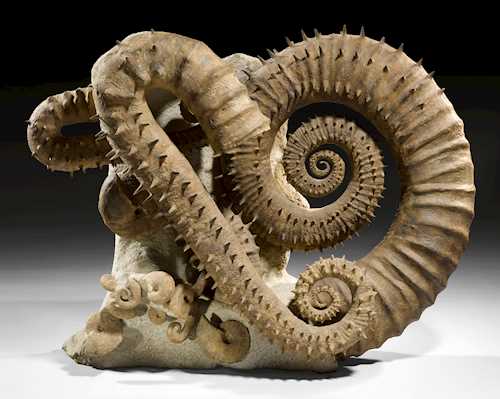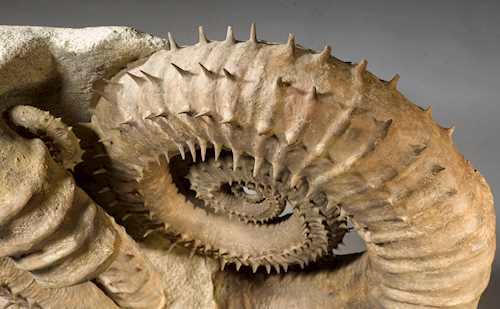
Lot 1893 - S17 Out of This World - Tuesday, 28. June 2022, 04.00 PM
AMMONITE GROUP
Emericiceras, Ancyloceras, Nautilus, Acrioceras, Crioceras, Barremites
Morocco, Tamanar region
Lower Cretaceous, Barremian, around 115 million years
80 x 80 cm
Morocco, Tamanar region
Lower Cretaceous, Barremian, around 115 million years
80 x 80 cm
Gutachten:
[Art.ArtText.Text@@1('[Art.BoId],21')]
[Art.ArtText.Text@@1('[Art.BoId],21')]
Provenienz:
[Art.ArtText.Text@@1('[Art.BoId],22')]
[Art.ArtText.Text@@1('[Art.BoId],22')]
Ausstellungen:
[Art.ArtText.Text@@1('[Art.BoId],23')]
[Art.ArtText.Text@@1('[Art.BoId],23')]
Ausstellung:
[Art.ArtText.Text@@1('[Art.BoId],24')]
[Art.ArtText.Text@@1('[Art.BoId],24')]
Literatur:
[Art.ArtText.Text@@1('[Art.BoId],25')]
[Art.ArtText.Text@@1('[Art.BoId],25')]
[Art.ArtText.Text@@1('[Art.BoId],26')]
Provenance: Swiss private collection
Ammonites are fossilized shells of extinct cephalopods and are equally important for the study of geology and paleontology. Thanks to their great variety of forms and unique beauty, they are popular collectors' items. Ammonites were named "Ammons horns" after the ancient Egyptian god of life and reproduction, who was usually depicted with ram's horns.
Ancyloceras is an extinct genus of heteromorph ammonites found worldwide during the Lower Cretaceous. The basic shape of the calcareous shell of the ammonites is a conical tube, which is rolled up in the manner of a logarithmic spiral to form a so-called plane spiral. Partly, housings developed, which unrolled in all spatial directions. The forms called aberrant or heteromorphic ammonites were considered for a long time as "abnormal", as evolutionary degeneracy. In part, this was even used to explain the extinction of ammonites. In more recent research, these forms are rather seen as adaptations to the strong sea level rises towards the end of the Secondary Era. Ammonites populated the seas during a long time, and the first known forms date from about 400 million years ago. They died out only at the end of the Cretaceous 65 million years ago, at the same time as the dinosaurs.
The group of ammonites presented here shows an incredible number of species and subspecies. The fascinating and almost impossible thing about this wonderful group is the fact that it was found and prepared exactly like this by a palaeontologist. The various cephalopods all show a very good state of preservation and very little restoration.
Ammonites are fossilized shells of extinct cephalopods and are equally important for the study of geology and paleontology. Thanks to their great variety of forms and unique beauty, they are popular collectors' items. Ammonites were named "Ammons horns" after the ancient Egyptian god of life and reproduction, who was usually depicted with ram's horns.
Ancyloceras is an extinct genus of heteromorph ammonites found worldwide during the Lower Cretaceous. The basic shape of the calcareous shell of the ammonites is a conical tube, which is rolled up in the manner of a logarithmic spiral to form a so-called plane spiral. Partly, housings developed, which unrolled in all spatial directions. The forms called aberrant or heteromorphic ammonites were considered for a long time as "abnormal", as evolutionary degeneracy. In part, this was even used to explain the extinction of ammonites. In more recent research, these forms are rather seen as adaptations to the strong sea level rises towards the end of the Secondary Era. Ammonites populated the seas during a long time, and the first known forms date from about 400 million years ago. They died out only at the end of the Cretaceous 65 million years ago, at the same time as the dinosaurs.
The group of ammonites presented here shows an incredible number of species and subspecies. The fascinating and almost impossible thing about this wonderful group is the fact that it was found and prepared exactly like this by a palaeontologist. The various cephalopods all show a very good state of preservation and very little restoration.
菊石组
Emericiceras, Ancyloceras, Nautilus, Acrioceras, Crioceras, Barremites摩洛哥,泰迈纳尔(Tamanar)地区下白垩统,巴雷姆期,约 1.15 亿年尺寸: 80 x 80 厘米
出处:瑞士私人收藏菊石是已灭绝的头足类动物的外壳化石,对地质学和古生物学的研究同样重要。由于它们的形式非常多样,而且具有独特的美感,所以是受欢迎的收藏品。菊石是以通常作为生命和生殖之神命名的古埃及公羊角来命名,被称为"公羊角"。Ancyloceras 是一种已灭绝的异形菊石属,被发现生长于下白垩纪期间的世界各地。菊石钙质壳的基本形式是锥形管,以对数螺旋的形式卷起,形成所谓的平面螺旋。有时候它的外壳可以向所有空间方向展开。长期以来,被称为反常或异形菊石的形式被认为是"不正常的",是一种进化上的退化。这有的时候甚至被用来解释菊石的灭绝。在最新的研究中,这些形式被视为试图适应第二时代末期海平面急剧上升的尝试。菊石长期存在于海洋中,因此大约在4亿年前就已经有了第一种物种。它们在6500万年前的白垩纪末期与恐龙同时灭绝。这里展示的这组菊石显示了令人难以置信的物种和亚种的数量。这个群组令人感到奇妙和几乎无法置信的是,它是由一个古生物学家这样发现和制作成的。各种头足类动物都显示出非常好的保存状态,很少有修复的痕迹。
CHF 25 000 / 50 000 | (€ 25 770 / 51 550)
Sold for CHF 36 900 (including buyer’s premium)
All information is subject to change.




